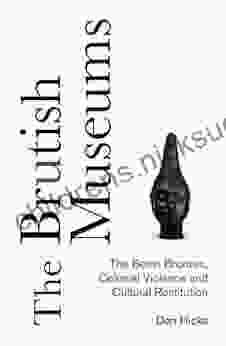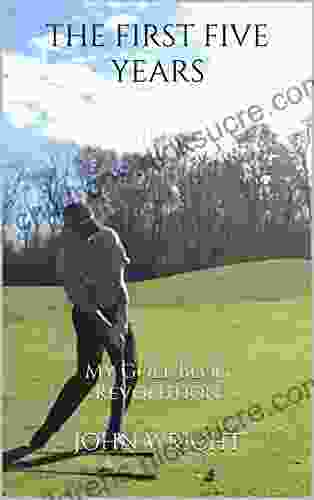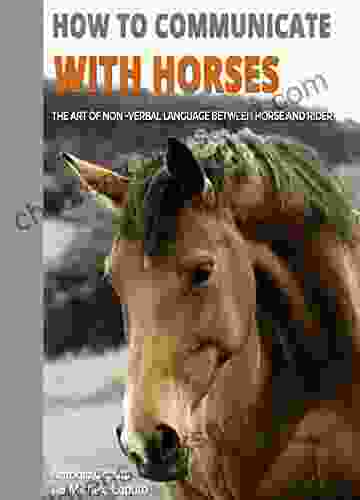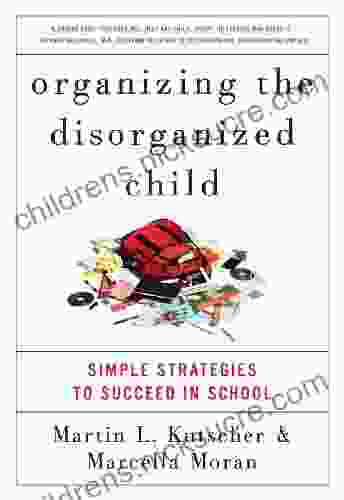The Art of Non-Verbal Language Between Horse and Rider: A Comprehensive Guide

Equestrianism, the art of riding horses, is a complex and rewarding discipline that requires a deep understanding and connection between horse and rider. Beyond the technical skills of mounting, dismounting, and controlling the horse's movements, the true mastery of horsemanship lies in the unspoken communication that transpires between the two partners.
4.6 out of 5
| Language | : | English |
| File size | : | 2427 KB |
| Text-to-Speech | : | Enabled |
| Enhanced typesetting | : | Enabled |
| Word Wise | : | Enabled |
| Print length | : | 151 pages |
| Lending | : | Enabled |
| Screen Reader | : | Supported |
This non-verbal language is a subtle yet powerful form of communication that allows horse and rider to convey messages, intentions, and emotions without uttering a single word. It is a language of body movements, facial expressions, and energy exchanges that facilitate a seamless and harmonious partnership.
Understanding Horse Body Language
Horses are highly expressive creatures, and their body language provides valuable insights into their thoughts, feelings, and intentions. Understanding these cues is essential for riders to effectively communicate with their mounts and ensure their safety and well-being.
- Ears: Horse's ears are highly mobile and can convey a range of emotions. Forward-pointing ears indicate alertness and interest, while flattened ears may signal fear, aggression, or annoyance.
- Eyes: The whites of a horse's eyes (known as the "sclera") are highly visible, allowing riders to gauge the horse's emotional state. Wide-eyed horses are typically calm and relaxed, while horses with squinted eyes may be suspicious or uncomfortable.
- Nostrils: Flared nostrils indicate excitement or agitation, while clamped nostrils may suggest fear or discomfort.
- Tail: The position and movement of a horse's tail can reveal various emotions. A high and arched tail typically signifies confidence and alertness, while a low and tucked tail may indicate fear or submission.
- Body Posture: Overall body posture can provide insights into a horse's mood and intentions. A relaxed horse with a lowered head and neck is typically calm and comfortable, while a horse with a tense and elevated head may be anxious or defensive.
Communicating with Your Horse
While horses are highly receptive to non-verbal cues, riders must also actively communicate with their mounts to establish clear and effective communication.
- Body Position: A rider's posture and balance on the horse's back can convey messages to the horse. A relaxed and centered posture with a slight forward lean indicates confidence and assertiveness, while a tense and unbalanced posture may communicate fear or uncertainty.
- Leg Cues: Riders use their legs to provide subtle cues to the horse, such as signaling to turn, stop, or speed up. Riders should use consistent and clear leg movements to avoid confusing the horse.
- Hand Position: The position of the rider's hands on the reins sends important messages to the horse. A light and steady hold conveys a relaxed and confident demeanor, while a tight or jerky grip may indicate nervousness or aggression.
- Seat: The rider's seat is a sensitive area that can convey a wide range of messages to the horse. A balanced and centered seat indicates confidence and control, while a shifting or unsteady seat may communicate anxiety or discomfort.
- Voice: While horses are not as reliant on vocal cues as humans, riders can use their voices for reassurance, praise, or correction. A calm and soothing voice can help to relax and calm the horse, while a sharp or angry tone may create tension or fear.
Developing a Harmony of Communication
Building a harmonious partnership with a horse requires consistent and patient communication on both sides. Riders should strive to develop a deep understanding of their horse's body language and respond in a way that is clear, consistent, and respectful.
- Observation: Spend ample time observing your horse's behavior and body language in different situations. This will help you to understand your horse's unique cues and responses.
- Consistency: Establish clear and consistent cues and rewards for desired behaviors. Horses learn best through repetition and positive reinforcement.
- Respect: Always approach your horse with respect and compassion. Avoid using force or harsh techniques, as this can damage the bond of trust and communication.
- Patience: Developing effective non-verbal communication takes time and patience. Be patient with your horse and yourself as you learn and grow together.
- Seek Professional Guidance: If you encounter difficulties in communicating with your horse, don't hesitate to seek guidance from a qualified equestrian instructor or veterinarian.
Non-Verbal Language in Different Equestrian Disciplines
The non-verbal language between horse and rider can vary depending on the specific equestrian discipline being practiced.
- Dressage: Dressage is a discipline that emphasizes precise and elegant movements. Non-verbal communication is paramount, as the rider must guide the horse through complex maneuvers with subtle cues.
- Jumping: Jumping requires a high level of trust and communication between horse and rider. The rider must convey the intended jump trajectory and height through body movements and leg cues.
- Endurance Riding: Endurance riding involves riding over long distances at a sustained pace. Non-verbal communication is essential for monitoring the horse's condition and ensuring its well-being throughout the ride.
- Western Riding: Western riding styles emphasize control and agility. Non-verbal communication is used to guide the horse through cattle work, roping, and other tasks.
The non-verbal language between horse and rider is an intricate and fascinating aspect of equestrianism. By understanding horse body language and communicating effectively through body movements, leg cues, and other subtle cues, riders can establish a deep connection with their mounts and achieve a harmonious partnership that enriches both the rider and the horse.
4.6 out of 5
| Language | : | English |
| File size | : | 2427 KB |
| Text-to-Speech | : | Enabled |
| Enhanced typesetting | : | Enabled |
| Word Wise | : | Enabled |
| Print length | : | 151 pages |
| Lending | : | Enabled |
| Screen Reader | : | Supported |
Do you want to contribute by writing guest posts on this blog?
Please contact us and send us a resume of previous articles that you have written.
 Fiction
Fiction Non Fiction
Non Fiction Romance
Romance Mystery
Mystery Thriller
Thriller SciFi
SciFi Fantasy
Fantasy Horror
Horror Biography
Biography Selfhelp
Selfhelp Business
Business History
History Classics
Classics Poetry
Poetry Childrens
Childrens Young Adult
Young Adult Educational
Educational Cooking
Cooking Travel
Travel Lifestyle
Lifestyle Spirituality
Spirituality Health
Health Fitness
Fitness Technology
Technology Science
Science Arts
Arts Crafts
Crafts DIY
DIY Gardening
Gardening Petcare
Petcare Anja Beran
Anja Beran James Nickells
James Nickells Eric Hanauer
Eric Hanauer Nancy Ellen Abrams
Nancy Ellen Abrams Dan Hicks
Dan Hicks Shane Frederick
Shane Frederick Frank Mastini
Frank Mastini Russ Mitchell
Russ Mitchell Lisa Gardner
Lisa Gardner Poul Anderson
Poul Anderson David Robert Grimes
David Robert Grimes Terry Hill
Terry Hill Jeff A Johnson
Jeff A Johnson Mark Bertin Md
Mark Bertin Md Henry A Giroux
Henry A Giroux Sharan B Merriam
Sharan B Merriam Julian Guthrie
Julian Guthrie R H Charles
R H Charles Dominique Pearson
Dominique Pearson Will Murray
Will Murray Robert H Shumway
Robert H Shumway Judy Cannato
Judy Cannato Vicki Lansky
Vicki Lansky Ray Bergman
Ray Bergman Tahereh Mafi
Tahereh Mafi Grant Mcomie
Grant Mcomie John Frohnmayer
John Frohnmayer Michael S A Graziano
Michael S A Graziano Paul Stewart
Paul Stewart Anil Ananthaswamy
Anil Ananthaswamy Marke Bieschke
Marke Bieschke Darren Kirby
Darren Kirby Bruce Feiler
Bruce Feiler Gail Carriger
Gail Carriger Jennifer Harvey
Jennifer Harvey Steph Davis
Steph Davis William H Parker
William H Parker Peter Julius Sloan
Peter Julius Sloan Brian Hayden
Brian Hayden Mia Collins Parker
Mia Collins Parker Jeff Driscoll
Jeff Driscoll David Poyer
David Poyer J Budziszewski
J Budziszewski Michael Deshotels
Michael Deshotels Benjamin T Mast
Benjamin T Mast Natale Barca
Natale Barca Robert Edelman
Robert Edelman Robin Barrett
Robin Barrett Janet Renner
Janet Renner Johnny Molloy
Johnny Molloy Val Waldeck
Val Waldeck Sadie Lake
Sadie Lake Nicholaos Kehagias
Nicholaos Kehagias Scott Keyes
Scott Keyes Bryson Payne
Bryson Payne Norman Hall
Norman Hall Nims Purja
Nims Purja Sarah Pink
Sarah Pink Kate Bowler
Kate Bowler Ann Cook
Ann Cook Ryan Boudreaux
Ryan Boudreaux Jennifer Dugan
Jennifer Dugan Karen Lynch
Karen Lynch Karen Jettmar
Karen Jettmar Discover Press
Discover Press Little Mat
Little Mat Peter Wacht
Peter Wacht Len Kravitz
Len Kravitz Jim Grimsley
Jim Grimsley J M Thompson
J M Thompson Joy Bauer
Joy Bauer Ania G
Ania G David J Lieberman
David J Lieberman Bill Bishop
Bill Bishop Miyamoto Musashi
Miyamoto Musashi Alana Ash
Alana Ash Tony Butt
Tony Butt Neil Smith
Neil Smith Richard Rorty
Richard Rorty Julius Evola
Julius Evola Jean Molesky Poz
Jean Molesky Poz Vivienne Crow
Vivienne Crow Angie Papple Johnston
Angie Papple Johnston Art Clepper
Art Clepper J W Lynne
J W Lynne T Chris Riley Tillman
T Chris Riley Tillman Paul Vachon
Paul Vachon Michael Edelson
Michael Edelson Joshua Wright
Joshua Wright Scott Cunningham
Scott Cunningham Nick Schade
Nick Schade Helen Czerski
Helen Czerski Shonda Schilling
Shonda Schilling Iain Mccalman
Iain Mccalman Ray Walker
Ray Walker Baby Professor
Baby Professor Tracy Salcedo
Tracy Salcedo Paul Eng
Paul Eng Judy Goodspeed
Judy Goodspeed Magnus D Jango
Magnus D Jango Steven Dillon
Steven Dillon Warren Berger
Warren Berger Antonia Malchik
Antonia Malchik Bill Fowler
Bill Fowler Phil G Tang
Phil G Tang Robert Jervis
Robert Jervis Beth Berry
Beth Berry Simon Boulter
Simon Boulter Robert G Bugge
Robert G Bugge Susan Zimmermann
Susan Zimmermann Ed Robinson
Ed Robinson Mary Helen Bowers
Mary Helen Bowers Stephen G Post
Stephen G Post Nikki Goth Itoi
Nikki Goth Itoi Angelo Tropea
Angelo Tropea James A Fain
James A Fain Sean Parker Dennison
Sean Parker Dennison Lin Lougheed
Lin Lougheed Laurie Varga
Laurie Varga Becky Choi
Becky Choi Martin L Kutscher
Martin L Kutscher Ann Marie Brown
Ann Marie Brown Cathy Glass
Cathy Glass Ryan Tandler
Ryan Tandler Sara Zaske
Sara Zaske Sherrie Eldridge
Sherrie Eldridge Terry Leiden
Terry Leiden Rachel Hartman
Rachel Hartman Robison Wells
Robison Wells Ariel Dalfen
Ariel Dalfen Kim Loraine
Kim Loraine Stephane Cazeault
Stephane Cazeault Guy Deutscher
Guy Deutscher David E Maranz
David E Maranz Eric Alpenfels
Eric Alpenfels Mari Silva
Mari Silva Michael Harris
Michael Harris Brianna Madia
Brianna Madia John Monyjok Maluth
John Monyjok Maluth Gary Sutherland
Gary Sutherland Ava Richardson
Ava Richardson Sarah Albee
Sarah Albee Kit Deslauriers
Kit Deslauriers Nicholas Wade
Nicholas Wade Deborah J Bennett
Deborah J Bennett L A Cotton
L A Cotton Emile Durkheim
Emile Durkheim Dean Karnazes
Dean Karnazes Tim Guest
Tim Guest Jan Witkowski
Jan Witkowski Shannon Philpott Sanders
Shannon Philpott Sanders Tim Kimmel
Tim Kimmel Scott Haugen
Scott Haugen Duncan Van Dusen
Duncan Van Dusen Mark Wilson
Mark Wilson 2nd Edition Kindle Edition
2nd Edition Kindle Edition Marc Weissbluth M D
Marc Weissbluth M D Tim Leffel
Tim Leffel John Romer
John Romer Nouaoui Khedidja
Nouaoui Khedidja Myron Mixon
Myron Mixon Dick Pobst
Dick Pobst Sue C Funnell
Sue C Funnell Deborah Hunter Kells
Deborah Hunter Kells Jim Burris
Jim Burris George Hincapie
George Hincapie Donovan Buck
Donovan Buck Sankofa Ra
Sankofa Ra Megan Hallett
Megan Hallett Philip P Massaro
Philip P Massaro Joanna Nylund
Joanna Nylund Bruce Gregor Hodge
Bruce Gregor Hodge Elisa S Amore
Elisa S Amore Phoenix Nature
Phoenix Nature Oswald Rivera
Oswald Rivera Dick Crouser
Dick Crouser Jason Aaron
Jason Aaron Michael Harner
Michael Harner John J Kaag
John J Kaag Jon G Hughes
Jon G Hughes Remmi Smith
Remmi Smith Susanne Elizabeth Freidberg
Susanne Elizabeth Freidberg Gary Robert Muschla
Gary Robert Muschla Marley Hall
Marley Hall David Rakel
David Rakel Max M Houck
Max M Houck Colin Rees
Colin Rees Waysun Liao
Waysun Liao Bob Stegner
Bob Stegner Larry Mueller
Larry Mueller Jimmy Song
Jimmy Song Erling Kagge
Erling Kagge Joe Shuber
Joe Shuber Willie Mosconi
Willie Mosconi David Deming
David Deming Lori Morrison
Lori Morrison Thomas Lewis
Thomas Lewis Illustrated Edition Kindle Edition
Illustrated Edition Kindle Edition Felicity Aston
Felicity Aston Jody Vasquez
Jody Vasquez D J Taylor
D J Taylor Benedict Go
Benedict Go Michele Caputo
Michele Caputo Jason Rosenhouse
Jason Rosenhouse Stan Lee
Stan Lee Tabatha Chansard Phd
Tabatha Chansard Phd Christof Koch
Christof Koch James Freeman
James Freeman Barry Correia
Barry Correia Tommy Shea
Tommy Shea Wendy Moore
Wendy Moore John Krige
John Krige Sharlene Healy
Sharlene Healy Jenna Tinsley
Jenna Tinsley Michael Yessis
Michael Yessis Marissa Zwetow Lmft
Marissa Zwetow Lmft William S Frisbee Jr
William S Frisbee Jr Elena Delle Donne
Elena Delle Donne Wendy Mogel
Wendy Mogel Melissa Watson
Melissa Watson Ichigo Takano
Ichigo Takano Jack El Hai
Jack El Hai Edward B Fiske
Edward B Fiske Ray Dozier
Ray Dozier Gordon Forbes
Gordon Forbes Sean Vigue
Sean Vigue Dr Richard L Travis
Dr Richard L Travis Kalman Samuels
Kalman Samuels Jeff Deters
Jeff Deters Sean Deveney
Sean Deveney Mayur Movalia
Mayur Movalia Mark Mayfield
Mark Mayfield Paul Volponi
Paul Volponi Tabatha Yeatts
Tabatha Yeatts Reed Mangels
Reed Mangels Patricia Ann Lynch
Patricia Ann Lynch Clinton Bailey
Clinton Bailey Lindsey Fitzharris
Lindsey Fitzharris Charlene Beswick
Charlene Beswick Jenny Carr
Jenny Carr Wade Bourne
Wade Bourne Doug Cook
Doug Cook Janet Patkowa
Janet Patkowa Damo Mitchell
Damo Mitchell Bruce Ackerberg
Bruce Ackerberg Iri Cermak
Iri Cermak Kumiko Makihara
Kumiko Makihara Shel Banks
Shel Banks Felice Benuzzi
Felice Benuzzi Karl Deisseroth
Karl Deisseroth Brent E Turvey
Brent E Turvey Imogen Barnacle
Imogen Barnacle Nick Clausen
Nick Clausen Rob Kelley
Rob Kelley Susie Albert Miller
Susie Albert Miller Shirley Maclaine
Shirley Maclaine Julie Gianelloni Connor
Julie Gianelloni Connor Lisa Charlebois
Lisa Charlebois William Lee
William Lee Dr Tracy Sanders
Dr Tracy Sanders Christina Tosch
Christina Tosch Anita Cortez
Anita Cortez Kenneth Wilgus Phd
Kenneth Wilgus Phd Eric B Taylor
Eric B Taylor Evelyn Monahan
Evelyn Monahan Johnegreek
Johnegreek Laurence Gonzales
Laurence Gonzales Shannon Greenland
Shannon Greenland Peter Lee
Peter Lee Peter Liljedahl
Peter Liljedahl Tri Thong Dang
Tri Thong Dang Kathy Fray
Kathy Fray Robin Esrock
Robin Esrock Rick Clark
Rick Clark Kristen S Kurland
Kristen S Kurland Dickie Bird
Dickie Bird Elliott Mendelson
Elliott Mendelson Beth A Grosshans
Beth A Grosshans Emma Hansen
Emma Hansen Chris Townsend
Chris Townsend Henny Bogan
Henny Bogan Govert Schilling
Govert Schilling David M Gitlitz
David M Gitlitz Ann Chamberlin
Ann Chamberlin Tracy Wolff
Tracy Wolff Sandra Cisneros
Sandra Cisneros Pete Earley
Pete Earley Don Larsen
Don Larsen Joshua Slocum
Joshua Slocum Tanya Holland
Tanya Holland Erin Davis
Erin Davis Justin Mcelroy
Justin Mcelroy Richard Paul Evans
Richard Paul Evans Steph Jagger
Steph Jagger Gavin Atkin
Gavin Atkin Joe Fox
Joe Fox Katherine Nichols
Katherine Nichols Richard J Davidson
Richard J Davidson Rebecca Rolland
Rebecca Rolland Paul Twitchell
Paul Twitchell Gregory J Stewart
Gregory J Stewart Behrouz Moemeni
Behrouz Moemeni Sharon N Covington
Sharon N Covington Aditya Chatterjee
Aditya Chatterjee Peter Galison
Peter Galison John Brockman
John Brockman Sherman Dickinson
Sherman Dickinson Anjeanette Carter
Anjeanette Carter Graham Allcott
Graham Allcott Simon Winchester
Simon Winchester Christina Mcghee
Christina Mcghee J M Adovasio
J M Adovasio Emily Teeter
Emily Teeter Jessica Redland
Jessica Redland Tami Oldham Ashcraft
Tami Oldham Ashcraft Peter Feinman
Peter Feinman Mike Lowery
Mike Lowery Kamran Nazeer
Kamran Nazeer Carla Hall
Carla Hall Tyler Ninja Blevins
Tyler Ninja Blevins Eric Wargo
Eric Wargo Joshua Straub
Joshua Straub Kevin Callan
Kevin Callan Edward O Thorp
Edward O Thorp Daniel Harman
Daniel Harman Robert A Sadowski
Robert A Sadowski Michael Easter
Michael Easter Flor M Salvador
Flor M Salvador Kevin Robbins
Kevin Robbins Al Goldis
Al Goldis Anthony Castrovince
Anthony Castrovince Ann Douglas
Ann Douglas Fred Heath
Fred Heath Scott Douglas
Scott Douglas Jada Fisher
Jada Fisher Ron Rhodes
Ron Rhodes Ann Mariah Cook
Ann Mariah Cook John Novosel
John Novosel Oliver Horovitz
Oliver Horovitz Emiko Jean
Emiko Jean Wendy Lyons Sunshine
Wendy Lyons Sunshine Roasted Rat
Roasted Rat Ann Cameron
Ann Cameron Judith A Muschla
Judith A Muschla Sadie Word
Sadie Word Tom Mole
Tom Mole Frank Falcinelli
Frank Falcinelli Lisa Hoehn
Lisa Hoehn Daniel Paolicchi
Daniel Paolicchi Eliot Cowan
Eliot Cowan Emma Anne Bellamy
Emma Anne Bellamy Miles Cameron
Miles Cameron Dr Gareth Moore
Dr Gareth Moore Rico Austin
Rico Austin Marc Roche
Marc Roche Mark Chang
Mark Chang Anita Knight Kuhnley
Anita Knight Kuhnley Joan Didion
Joan Didion Rae Brewer
Rae Brewer Ben Magid
Ben Magid Jessica Hall
Jessica Hall Lara Maiklem
Lara Maiklem Yuri Kitayama
Yuri Kitayama Jack O Connor
Jack O Connor John Heart
John Heart One Exam Prep
One Exam Prep Victoria Clarke
Victoria Clarke Helen Yang
Helen Yang Frances Gies
Frances Gies Max Kuhn
Max Kuhn Weston Ochse
Weston Ochse Brendan Leonard
Brendan Leonard Tina Payne Bryson
Tina Payne Bryson Joshua Glenn
Joshua Glenn Elwyn Hayes
Elwyn Hayes Shalane Flanagan
Shalane Flanagan Brian Platzer
Brian Platzer Kaylind Olson
Kaylind Olson Ann Israel
Ann Israel Ann Leary
Ann Leary Samuel G Puryear
Samuel G Puryear Brian Smith
Brian Smith John Feinstein
John Feinstein Douglas Axe
Douglas Axe Jean Rose
Jean Rose Imre Lakatos
Imre Lakatos Sara Dykman
Sara Dykman Frederick Lewis Allen
Frederick Lewis Allen Rc Blakes Jr
Rc Blakes Jr Beth Cavenaugh
Beth Cavenaugh Steve Economides
Steve Economides Scholastic
Scholastic Marck Vaisman
Marck Vaisman Chuck Robbins
Chuck Robbins Laura M Ahearn
Laura M Ahearn Enrique Desmond Arias
Enrique Desmond Arias Cynthia Miller Idriss
Cynthia Miller Idriss Brian Burke
Brian Burke L R Shorter
L R Shorter Jerry C Whitaker
Jerry C Whitaker Jeremy Griffith
Jeremy Griffith Darlene D Pedersen
Darlene D Pedersen Stanley Vestal
Stanley Vestal Stu Ingraham
Stu Ingraham Cgp Books
Cgp Books Deena Kastor
Deena Kastor Jade Mckenzie Stone
Jade Mckenzie Stone Chad Wesley Smith
Chad Wesley Smith Ann Imig
Ann Imig Larry Greene
Larry Greene Martina Sprague
Martina Sprague Jena Pincott
Jena Pincott Tom Dokken
Tom Dokken Cindy Hudson
Cindy Hudson Presh Talwalkar
Presh Talwalkar Josh Kaufman
Josh Kaufman Paul Fowler
Paul Fowler Comni S Art Publishing
Comni S Art Publishing Jane Goodall
Jane Goodall Stewart Pearce
Stewart Pearce Angie Stanton
Angie Stanton Chris Dombrowski
Chris Dombrowski J L Heilbron
J L Heilbron Dale Grdnic
Dale Grdnic Dorothy Roberts
Dorothy Roberts J M Gregson
J M Gregson Sarah J Tracy
Sarah J Tracy Stephanie Garber
Stephanie Garber Frank X Sutman
Frank X Sutman Sharon Cameron
Sharon Cameron Jazmine Mccoy
Jazmine Mccoy Michael Kranish
Michael Kranish Dale Peterson
Dale Peterson Anita Biase
Anita Biase Steven Cowie
Steven Cowie Kristin Knight Pace
Kristin Knight Pace Julie Knutson
Julie Knutson Julie Watson
Julie Watson Julie Cwikla Phd
Julie Cwikla Phd William J Ray
William J Ray Thomas Thompson
Thomas Thompson Namit Arora
Namit Arora Chris Matakas
Chris Matakas Rebecca M Warner
Rebecca M Warner Elizabeth G Harper
Elizabeth G Harper Angie Thomas
Angie Thomas Richard Weaver
Richard Weaver Paul Hough
Paul Hough Rachel Levin
Rachel Levin Clayton Geoffreys
Clayton Geoffreys Douglas Turkington
Douglas Turkington Bob Greene
Bob Greene F C Yee
F C Yee Persia Woolley
Persia Woolley Lindsey Hutchinson
Lindsey Hutchinson Intisar Khanani
Intisar Khanani Rosanne S Mchenry
Rosanne S Mchenry Terry Tempest Williams
Terry Tempest Williams Katherine Keith
Katherine Keith Elizabeth Wayland Barber
Elizabeth Wayland Barber Danielle Centoni
Danielle Centoni Vera Snow
Vera Snow David J Wallin
David J Wallin Tennille Chaffin
Tennille Chaffin Molly Harper
Molly Harper Hippocrates
Hippocrates Bookrags Com
Bookrags Com Elissa Altman
Elissa Altman Caleb Lee
Caleb Lee Deborah Reber
Deborah Reber Sherri Mitchell
Sherri Mitchell Ronald M Holmes
Ronald M Holmes Tyler Feder
Tyler Feder Daxton Wilde
Daxton Wilde Don Jose Ruiz
Don Jose Ruiz Sara Wolf
Sara Wolf Hugh Harris
Hugh Harris Ann Bingham
Ann Bingham Laurie R King
Laurie R King Peter Croker
Peter Croker Isla Gordon
Isla Gordon Sandra Steingraber
Sandra Steingraber Jennie Germann Molz
Jennie Germann Molz Kathy Borkoski
Kathy Borkoski Quinn Loftis
Quinn Loftis Hunter S Fulghum
Hunter S Fulghum Je Earl
Je Earl Brook Waters
Brook Waters James Campbell
James Campbell Carl J Pratt
Carl J Pratt M K Hume
M K Hume David Roche
David Roche Eugene Hecht
Eugene Hecht Michelle Hercules
Michelle Hercules Jean Paul Pequegnot
Jean Paul Pequegnot Ann Bausum
Ann Bausum Emily R King
Emily R King Gina Atencio Maclean Psyd
Gina Atencio Maclean Psyd Buster Holmes
Buster Holmes Dr Mike Dilkes
Dr Mike Dilkes Mary O Hora
Mary O Hora Richard Karban
Richard Karban Alex Bonham
Alex Bonham
Light bulbAdvertise smarter! Our strategic ad space ensures maximum exposure. Reserve your spot today!

 August HayesA Comprehensive Summary Study Guide to Pablo Neruda's Extraordinary Life and...
August HayesA Comprehensive Summary Study Guide to Pablo Neruda's Extraordinary Life and...
 Orson Scott CardThe Benin Bronzes: A Legacy of Colonial Violence and the Imperative for...
Orson Scott CardThe Benin Bronzes: A Legacy of Colonial Violence and the Imperative for... Isaias BlairFollow ·15.5k
Isaias BlairFollow ·15.5k E.E. CummingsFollow ·17.9k
E.E. CummingsFollow ·17.9k Andy ColeFollow ·7.8k
Andy ColeFollow ·7.8k Felipe BlairFollow ·8.1k
Felipe BlairFollow ·8.1k Carlos DrummondFollow ·7.6k
Carlos DrummondFollow ·7.6k Ethan GrayFollow ·3.5k
Ethan GrayFollow ·3.5k Vladimir NabokovFollow ·18.6k
Vladimir NabokovFollow ·18.6k Dominic SimmonsFollow ·4.1k
Dominic SimmonsFollow ·4.1k

 Ernest J. Gaines
Ernest J. GainesMy Golf Blog Revolution: Open Stance
Are you ready to revolutionize your golf...

 Gene Powell
Gene PowellThe Unparalleled Genius of Calculus Volume Ichigo Takano:...
: The Birth of a...

 Edgar Hayes
Edgar HayesChild of the Northern Spring: A Journey of Discovery and...
In the heart of...

 Anthony Wells
Anthony WellsHybrid Aria: A Harmonious Blend of Modern Comfort and...
In the heart of a bustling...
4.6 out of 5
| Language | : | English |
| File size | : | 2427 KB |
| Text-to-Speech | : | Enabled |
| Enhanced typesetting | : | Enabled |
| Word Wise | : | Enabled |
| Print length | : | 151 pages |
| Lending | : | Enabled |
| Screen Reader | : | Supported |












